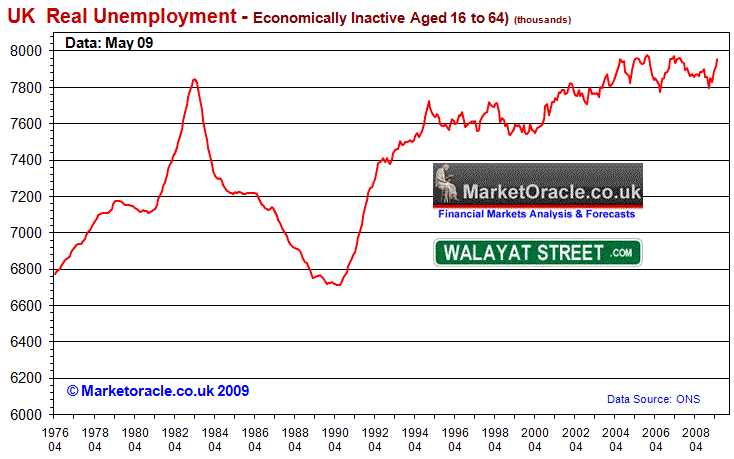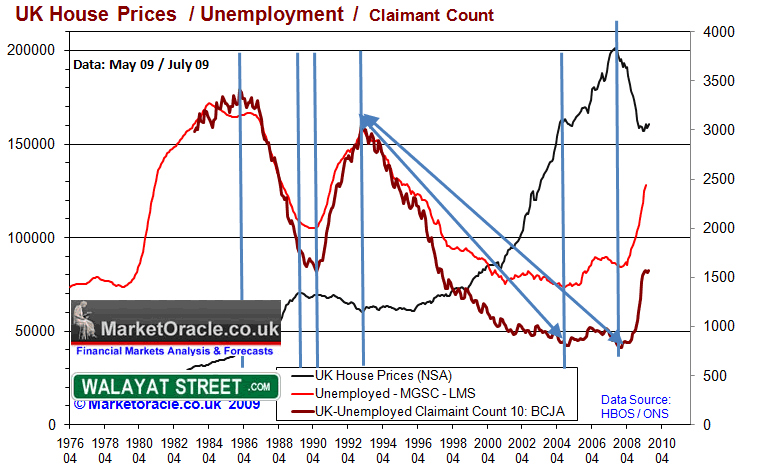UK Housing Market Crash and Depression Forecast 2007 to 2012
Housing-Market / UK Housing Jan 04, 2009 - 11:19 PM GMTBy: Nadeem_Walayat

 Recent house price data as released by the Halifax showed that UK house prices have plunged by more than 20% from the peak of August 2007, which has fulfilled much of the original forecast made in August 2007 for a minimum fall of 15% for the UK housing market and 25% for London, therefore this analysis seeks to project the forecast trend for UK house prices for the next 3 years into 2012.
Recent house price data as released by the Halifax showed that UK house prices have plunged by more than 20% from the peak of August 2007, which has fulfilled much of the original forecast made in August 2007 for a minimum fall of 15% for the UK housing market and 25% for London, therefore this analysis seeks to project the forecast trend for UK house prices for the next 3 years into 2012.
UK Housing Market Background and Re-cap.
August 2007 Forecast Conclusion - The UK Housing market is expected to decline by at least 15% during the next 2 years. Despite the 2012 Olympics, London is expected to fall as much as 25%. UK Interest rates are either at or very near a peak, as there is an increasingly diminishing chance of a further rise in October 2007. After which UK interest rates should be cut as the UK housing market declines targeting a rate of 5% during the second half of 2008. The implications for this are that the UK economy is heading for sharply lower growth for 2008.
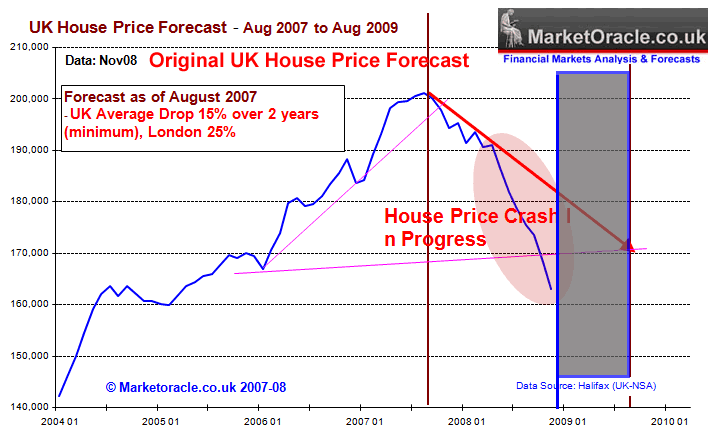
The Credit Crunch Trigger - The first signs of the housing market moving towards an imminent peak occurred in February 2007 following clear evidence that the subprime mortgages were defaulting in ever greater numbers in the United States, the assumption here was that this could lead to a unraveling of the carry trade which would lead to deleveraging of the credit boom. However the initial financial markets wobble of February 2007 failed to show outward evidence of a credit crunch, thus the UK housing market continued to rise despite rising interest rates that had been forecast in November 2006 to rise to a peak of 5.75% by September 2007 as the Bank of England would battle with inflation during 2007.
The housing market took off into what would be its final spike higher with many commentators declaring at the time a new paradigm, with many reasons put forward as to why house prices could be supported indefinitely.
Reasons Given as to Why the Housing Market would not Fall:
Immigration - There had been a large influx of over 800,000 migrants from the Accession states who contributed towards the buy to let market bubble.
Lack of Home Building - Up until early 2007 there had not been a building boom in the UK housing market in the form of traditional terrace and semi-detached properties. However this hid the speculative boom going on in the construction of the off the plan flats and apartments that proceeded to transform many city centre developments that were due to be completed during 2007 and 2008, this would bring online a huge supply of over priced properties that would require ridiculously high rentals to prove profitable as frenetic property speculators grossly over paid for the flats.
Strong UK Economy - The UK economy at the centre of the worlds credit bubble continued to outperform mainland Europe, which looked on with envy from the less flexible and more regulated European countries of France and Germany, though as we find out during 2009, not participating in the credit boom did not help them as many of the European banks become belatedly suckered into buying U.S. subprime mortgage backed toxic securitized debt as one the last to fling themselves onto the debt derivatives pyramid.
Already dark clouds had starting forming over the UK housing market during the summer of 2007, as I voiced on 1st of May 2007 ( UK Housing Market Heading for a Property Crash)
The credit market conditions continued to deteriorate at an increasing rate during the summer months as the spread between the base rate and sterling LIBOR widened from. The situation came to a head during July 2007 with the blow of the Bear Stearns hedge funds at a cost of $5 billion and later led to the credit crunch occurring in August 2007 which to derivatives market participants implied that the housing market could not rise any further under these conditions and had in fact peaked in the month of August, which is what actually transpired on release of subsequent house price data.
UK Housing Market 2008 Crash Trigger - Following the peak in UK house prices, the initial trend was inline with the original forecast, however it was recognised following Northern Rocks bust that the pace of deterioration of credit markets as well as the capital gains tax changes as implying that the UK housing market's rate of decent would start to accelerate from April 2008 and could be termed as a housing market crash - November 2007 - Crash in UK House Prices Forecast for April 2008 As Buy to Let Investors Sell. - The timing for the sharp drop is likely to coincide with Labour's change on capital gains tax which effectively cuts the tax payable on gains accumulated over the last few years to 18% from 40%. This tax change comes into force on 1st of April 2008 and thus the expectation is for an avalanche of selling amongst buy to let investors to lock in profits.
This also means that the market will to some degree be artificially supported going into April 08, but still will not be enough to prevent a wider decline in UK house prices but rather could register a drop of as much as 5% in the quarter April 08 to June 08 , which would represent a crash in UK house prices.
July 2008 - UK House Price Crash In Progress! - The summer months subsequently witnessed the crash in UK house prices come to pass as house prices look set to fullfill the original forecast for a 15% fall well ahead of the original time line with the risks that despite soaring inflation data, the housing bear market threatened imminent deflation, which has now increasingly become the mainstream story which was originally highlighted in the analysis of March 2008.
The Government Starts to Panic - House prices continued to fall into September 2008 as increasingly bankrupt banks started to topple over one after another as governments scrambled with ever more panicking measures to prevent a collapse of the global financial system. First came the ban on short selling of financial stocks, then nationalisation of Bradford and Bingley, followed by the panic interest rate cut of October 2008, and the unprecedented £500 billion bank bailout package. As the financial markets continued to experience extreme volatility by registering daily movements of as much as 10% that have not been seen since the days of the 1987 Crash, the Government effectively took control of interest rates in all but name away from the Bank of England which announced the panic interest rate cut of 1.5% at the November MPC meeting that truly brought home how quickly the economy was falling off the edge of the cliff and the subsequent emergency VAT cutting budget in an attempt to get consumers to spend immediately which brings us up to the present.
HBOS - Britain's Biggest Mortgage Bank
 In August 2007, I warned about the precarious state of Northern Rock Bank and how the prospects for its survival during the the imminent housing bear market were not looking good. Fast forward 12 months and we found Britain's biggest mortgage Bank the Halifax, a financial institution that lies at the very heart of the British housing market that teetered on the brink of collapse in mid September under fierce hedge fund short selling assault that smelled blood for the third time this year, the first time was way back in March 2008, with analysis of the latest assault published a good 24 hours before the mainstream press began reporting on the HBOS crisis. It was the short selling of HBOS towards financial oblivion that forced the FSA to ban short selling of financial stocks some 3 days later.
In August 2007, I warned about the precarious state of Northern Rock Bank and how the prospects for its survival during the the imminent housing bear market were not looking good. Fast forward 12 months and we found Britain's biggest mortgage Bank the Halifax, a financial institution that lies at the very heart of the British housing market that teetered on the brink of collapse in mid September under fierce hedge fund short selling assault that smelled blood for the third time this year, the first time was way back in March 2008, with analysis of the latest assault published a good 24 hours before the mainstream press began reporting on the HBOS crisis. It was the short selling of HBOS towards financial oblivion that forced the FSA to ban short selling of financial stocks some 3 days later.
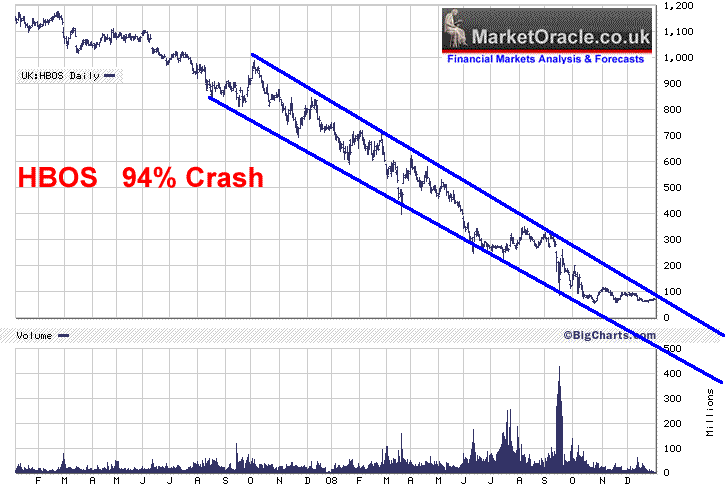
The HBOS Share price has crashed by over 94%, and is indicative of the severe nature of the current housing bear market, trading at just 73p the once mighty HBOS has now become another penny stock with the value of shareholdings further diluted via state capital injections to keep the zombie bank from flat-lining.
Vested Interests Try to Talk the Market Higher
To date the Nationwide and Halifax have not made a forecast for 2009, which is not surprising given the failure to date to accurately track the housing market decline as all mortgage banks have a vested interest in talking up the market just as transpired in the early stages of the 1990's housing bear market as I highlighted in the September 2007 article - UK Housing Market on Brink of Price Crash - Media Lessons from 1989! The whole of the decline for 2007 was associated with the phrase 'Soft Landing' which continued into early 2008 after which the phrase disappeared from the mortgage bank press releases. Still in early 2008 the Halifax continued to imply that UK house prices would not turn negative during 2008. On the other side of the equation there were the perma bears such as Capital Economics which had been repeatedly calling for a 20% to 30% drop in UK house prices since 2002.
CURRENT UK HOUSING MARKET ANALYSIS AND FORECAST TRENDS
UK Mortgage Supply Crash
The panic interest rate cuts from 5% straight to 2% in 2 months and the £600 billion bank bailout package are aimed at unfreezing the UK banking system so as to enable the banks to resume near 'normal' lending operations and support the economy and housing market as the number of mortgage approvals collapses. The most recent data from the British Bankers Association (BBA) shows a sharp fall in the number of mortgages approved for house purchases to 17,773 against 64,014 in July 2007, a fall of 72%. Similarly loans for equity withdrawals which has been pivotal to Britain's consumer boom as home owners borrowed against equity to spend has fallen by 49%. The net effect of this is that the total amount of mortgage loans outstanding has shrunk by some £35 billion, against a stable mortgage market which would have required an increase of at least £25 billion over the same period.
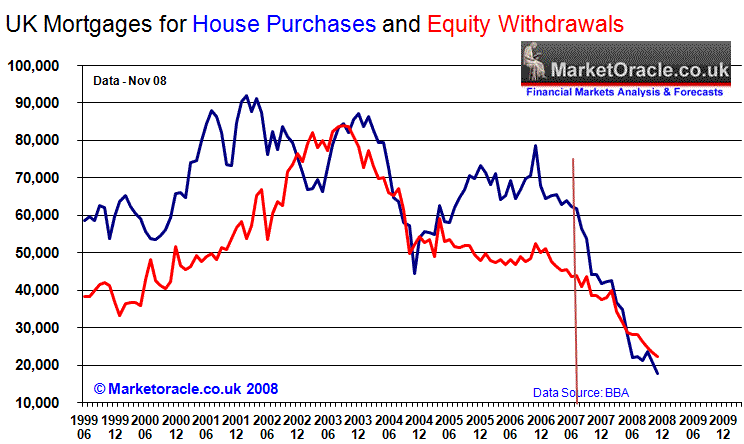
At the same time as supply has fallen so has the average value of loan offered for house purchases which peaked at £159,600 in June 2007, and now averages at just £116,700. This is highly deflationary for UK house prices and implies a reduction in house prices of £42,900 against an actual price fall of £38,000 (Nov08) and therefore acts as a leading indicator for the continuing downtrend in house prices as the amounts made available for mortgages contracts inline with the tightening lending criteria both in terms of salaries and Loan to Value ratios of 75% or less.
The deep interest rate cuts on face value seem like a great time for home owners to seek to remortgage, however there is a hidden price to pay if home owners are not careful, and that is firstly in the clauses of penalties for early remortgaging, and secondly in that distressed mortgage banks are reluctant to take on new mortgage customers, which means that home owners need a sizeable level of equity in the order of 25% or more. Now here is the crunch point, the equity percentage is based on the valuation that the mortgage bank puts on your house and NOT at the peak price or imagined current valuation that the homeowner may have had in mind, and in that respect expect the mortgage banks surveyor will tend to discount your home valuation against further price falls so as to arrive at a worse case scenario for the bank. What this means is that home owners imagining that they are sitting on equity of 25% despite the fall in house prices to date may in fact on attempting to remortgage find that the mortgage bank under values to the degree where they are in actual negative equity for mortgage purposes and hence not offered any loan at a favourable interest rates.
This therefore negates much of the recent deep rate cuts whether passed on or not as the best the mortgage borrowers can obtain are the standard variable rates that do not better the existing expiring fixed deals. This is highly bearish for the housing market as a self feeding mechanism has an inbuilt freeze for the remortgage market which is reflected in the crash the number of mortgages.
The mortgage market clearly remains frozen as extreme measures are taken to prevent the collapse of Britain's biggest mortgage banks. The situation remains dire with little appetite amongst the banks to open their doors and invite in borrowers to take on debt into the second year of a literally crashing UK housing market. Today's mortgage market is not going to support the current salary to house price ratios of between X4.5 and X6, lending criteria's have become increasingly tight with demands of 25% deposits becoming the norm and loans maxing out at X3.5 salaries so as to reduce the risk and volume of new business. The banks do not want to take on risky borrowers in the middle of a house price crash, the days of easy mortgages of 100% at X6 salary or higher are gone. Therefore as the banks credit market positions are deleveraging so is the housing mortgage market deleveraging towards trend, and in that trend is measured by X3.5 earnings which suggests house prices have some 20% further to drop.
UK Housing Market Affordability Index
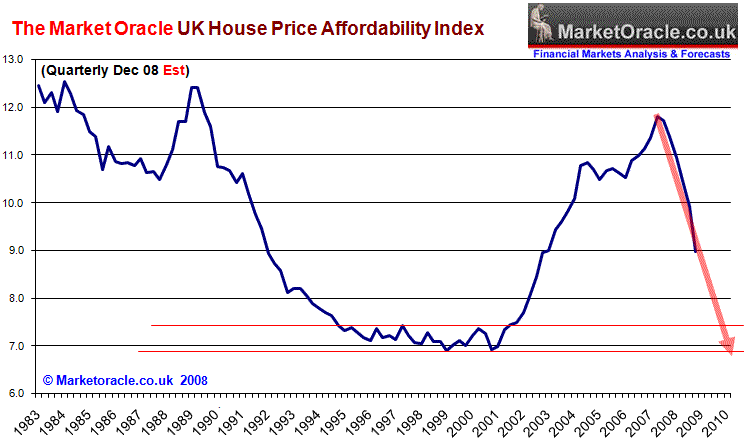
The 19% fall in UK house prices coupled with continuing rise in average earnings has led to a sharp fall in the Market Oracle affordability index which attempts to more accurately track affordability than the traditional salary to mortgage ratio. The trend over the last 18 months continues to target a rapid decline towards a low of between 7.0 and 7.5 by late 2010. However given the rapid pace of decline there exists a serious risk of overshoot to the downside i.e. for the UK housing market affordability index to bottom at a rate that would make housing cheaper than that of the mid 1990's in relative terms. This implies that the UK housing market is approximately half way towards its lows and therefore equates to a 38% fall from the August 2007 high.
Buy to Let Investors Rush for the Exit
According RICS rents are falling for the first time since 2003 which turns the tables on landlords as tenants can force landlords to not only freeze rents but ask for deflationary cuts in rents which therefore puts further pressure on the buy to let business models that relied heavily on capital gains which has now been replaced by severe capital losses. Therefore buy to let investors are losing thousands on each property every month that they continue to hold onto loss making investments. This coupled with evidence that the flood of eastern european workers demand for rental properties is diminishing as european migrants are increasingly deciding to return home in the face of the increasingly severe UK recession that ensures that the prospects for buy to let investors is dire for several years and it is this which has contributed towards the severe nature of the UK housing market crash which has all the hallmarks resulting in an unprecedented rate of decline.
Middle Eastern Investors Dumping London Properties ?
To make matters worse for London which is already reeling from the depression in the financial sector, what support the London housing market had from the flood of petro dollars has evaporated following the great Oil Price crash of 2008, that has seen the inflation hedging of the first half of 2008 turn into the Deleveraging deflation of the second half following the peak at $147. Inexperienced Middle eastern and asian sovereign wealth funds that have plowed billions into the bankrupt banks starting late 2007 are now in no mood to lose even more on plunging london properties, therefore Londoners should not delude themselves into thinking cheaper prices will entice foreign investors to return any time soon, therefore expect much deeper falls for London house prices than the rest of the country as my original analysis and forecast concluded.
Corporate Housing Market Goes Bust
Having warned in August 2007 to avoid property and related investment funds due to the risk that in a crisis they could literally freeze, this actually came to pass in December 2007 as Britain's fourth biggest insurer, Friends Provident froze its Property Fund. The reason for the freeze was that once the cash reserves had been consumed the funds would be forced to liquidate assets, which means sell properties, which applies to all commercial property funds that saw the smart money attempting leave the scene before the avalanche of redemptions began. This was later followed during September 2008 by the great deleveraging crash that threatened to consume across the board funds as financial markets teetered on the brink of a collapse.
Repossessions - Extreme Government Pressure
In an attempt to limit the number of repossessions during 2009, the government is putting extreme pressure on the mortgage banks to ensure repossessions are a last resort. Up until September 2008 this amounted mostly to hot air from the politicians, however after having taken major stakes in most of Britain's biggest banks there are strong signs that the banks are starting to comply with their new majority shareholder's wishes (the government), that look set to increasingly introduce initiatives to reduce the number of repossessions. The most recent action on this front was by RBS which stated that it would give a 6 month reprieve to its mortgage customers that are in arrears before initiating court repossession orders.
Whilst the measures will undoubtedly mean that less homes will now be repossessed than would have otherwise been the case, however it does act as a two edged sword in that whilst supply of repossessed homes onto the market will be less, at the same time the mortgage banks are being forced to carry loss making loans that prove costly to administer and without bringing in much needed revenue i.e. tieing up resources that could have gone to more profitable mortgage customers.
The Governments initiatives to reduce repossessions will have no discernable impact on the housing market price trends either positive or negative due to the points about tieing up capital in loss making costly to administer loan accounts. The number of homes expected to be repossessed during 2008 is now revised lower to 55,000 with the expectations of 65,000 homes for 2009 in advance of further government interventions in the housing market to prevent repossessions on an larger scale.
UK Interest Rates - House Price Deflation Vs Mortgage Interest Rate Relief
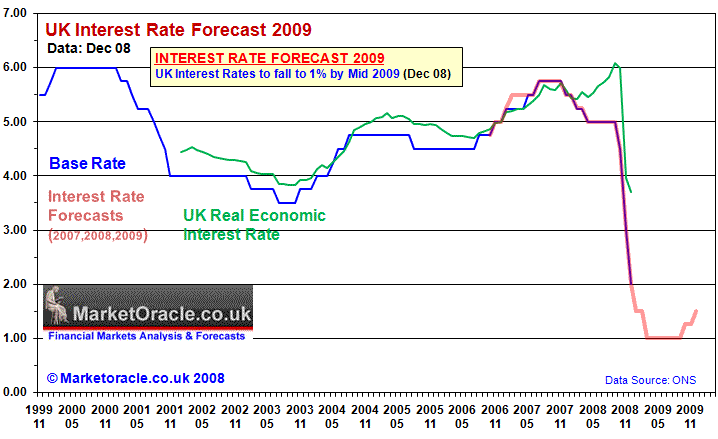
The government is engaged on a programme of forcing down mortgage interest rates by a series of deep unprecedented cuts in UK interest rates towards the target of 1% , and possibly even lower to make up the shortfall in the lack of responsiveness by mortgage lenders in cutting their rates, who at the same time have tightened lending criteria due to the increased risk of defaults.
The mortgage interest rates have fallen significantly from the credit crisis extremes and are heading to below 4% which implies a strong pointer for support for house prices as the cost of servicing mortgages falls and therefore 'should' support a recovery in housing prices. However the housing market has always been that of being driven by sentiment, in that it is the trend in house prices that is most significant and NOT the cost of servicing the mortgages, it is this which pushed house prices to above X7 earnings, where people were prepared to take on large mortgages at high interest rates for the prime reason that house price gains in the order of 15% per annum or more were far above that of the mortgage interest payments of typically 6%.
However now that the housing bubble has burst has resulted in the trend and sentiment reversing as house prices have already fallen by nearly 20%, which equates to a loss of £40,000 on an average £200,000 house that is now worth £160,000, which averages to a fall in value of £2500 per month. Against which a typical mortgage of say £160k on a £200k property at 6% would result in monthly interest charge of £800 per month. Now with mortgage rates having typically fallen to 4% which is resulting in an reduced interest payment of £533 per month or a significant fall of £277 per month that many commentators are taking as a cue for imminent price stability. Unfortunately the £277 saving is just above 10% of the amount that home owners are typically losing in value per month! Therefore the interest rate cuts are having little if no effect on the housing market, I first warned of this likely outcome back in February 2008 that interest rate cuts will not stop house prices from falling.
This therefore implies that low interest rates are not an important factor at this point in determining house price trend during 2009, as housing market sentiment is decidedly bearish and will take time to first stabilise and then start to recover.
LIBOR
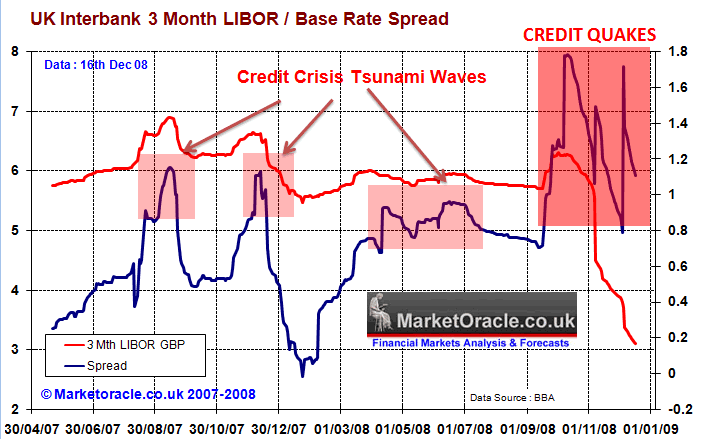
The credit markets as measured by the headline London Interbank Offered rate (LIBOR) has fallen inline with the deep interest rate cuts. However the true measure of the credit crisis and the reluctance of the banks to lend to one another as measured by the spread between the LIBOR rate and the base interest rate remains at credit crisis extremes as the above graph illustrates, which suggests the banks are still not prepared to lend to one another, and if they are still reluctant to lend to one another that means that the mortgage freeze is expected to deepen further as the economy moves into a deep recession.
Many banks led by the nationalised banks are eagerly seeking to reduce their exposure to the UK housing market by forcing borrowers to either stay and pay the premium of a high standard variable rate or to remortgage elsewhere, as their fixed rate deals expire.
The implications are extremely severe for the UK housing market as there is nothing to suggest that a turnaround in mortgage credit markets is around the corner regardless of what happens to the LIBOR rate, therefore this supports the view that falling house prices will be eventually followed by a housing market depression i.e. a resurgent bull market is many years away, perhaps as long as 5 years.
UK Economic Recession - Unemployment
UK unemployment has probably already risen above 2 million by the time Decembers data is released in March, with the original UK unemployment forecast for a rise to 2.6 million by April 2010 now destined to be breached as the UK economy targets a severe recession on par with that of the early 1980's rather than the more milder one of the 1990's. Increasing expectations are that the UK economy will contract by 3% GDP during 2009 which implies that the UK is heading for an unemployment rate that could pass above 3,000,000 by early 2010.

Therefore this confirms that the UK housing market is at least 15 months away from a period of stabilising in nominal terms i.e. where house prices stop falling. The actual trigger for a resumption of the housing bull market would be a sustained period of falling unemployment with the trigger level of 2,000,000 expected to act as a strong marker for year on year housing market recovery as occurred following the last housing bear market. This suggests that the housing market may not embark on an sustainable up trend for as longs as another 4 years and thus points to a period of house price stagnation that will following the current crash in UK house prices.
UK Government Debt Levels Explode Higher
Gordon Brown for 10 years banged the drum of the 40% public sector debt rule as a sign of fiscal responsibility. However following Northern Rocks collapse, the government has increasingly employed creative accounting to hide the fact that the rule has long since been broken. The nationalisation of Northern Rock and then Bradford and Bingley put paid to that. This was followed by the budget busting bank bailouts of September totaling £600 billion. Having thrown in the towel, the Labour government is going for broke with ever larger spending announcements that look set to take UK debt towards £1 trillion by the end of 2009, lifting public debt to more than 80% of GDP.
However the consequences of the borrowing binge is the crash in sterling, as investors adjust to the new climate of growing budget deficits.
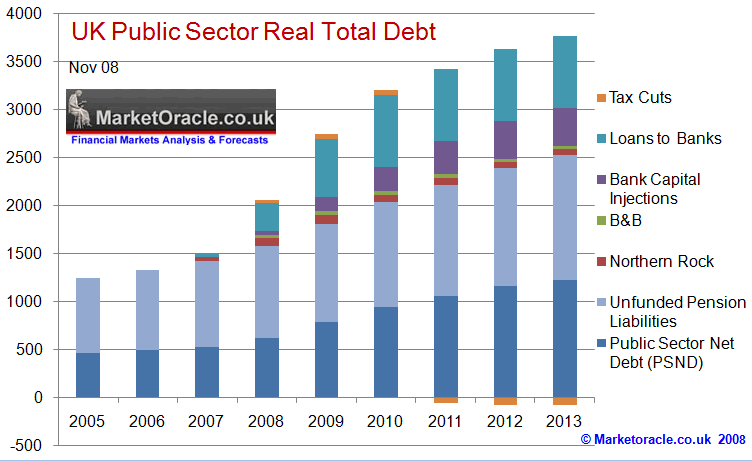
The government's deficit spending will continue into 2010 and right upto the general election deadline as the government is expected to announce even more tax cuts and spending programme's in an attempt to win votes. Therefore the first 5 months of 2010 could also witness another £100 billion additional debt, which would push government borrowing beyond 90% of GDP onwards and upwards towards 100% of GDP that will leave a huge inflationary hangover for many years following the 2010 election deadline. However the true level of liabilities as the above graph highlights are significantly above £1 trillion that may prove to be officially recorded public debt level, instead of the actual levels of above £3 trillion by 2010.
The consequences of government borrowing and ever expanding liabilities is below trend economic growth and high inflation. This supports the view that the UK housing market will enter a real terms depression following the ongoing crash, with little on the horizon that could ignite a new bull market for at least the next 4 years.
There also exists the doomsday scenario that the government may yet be forced to nationalise the entire banking sector that would involve liabilities expanding by an additional £5 trillions. Under those circumstances Britain would be heading for hyper-inflation which whilst supporting house prices in nominal terms, would greatly erode their value an real terms as Britain's real GDP would contract by significantly more than the 4% that the current recession is expected to shave of the economy.
UK GDP House Prices Trend
Whilst many methods have been utilised in determining future housing market trend such as on the basis of average earnings, mortgage interest rates, currency valuation, inflation adjusted, comparison against other housing markets and real disposable earnings, this item brings to the table housing market analysis against UK GDP growth. The assumption here is that the value of assets after stripping out inflation should increase in inline with the countries actual growth rate as measured by gross domestic product.
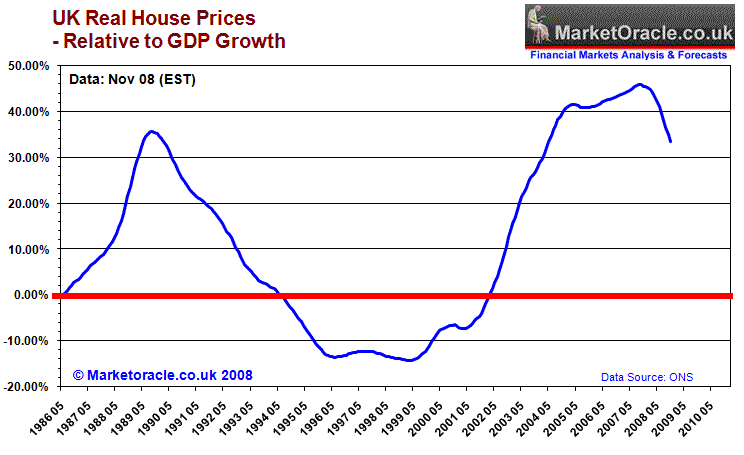
The above graph illustrates that the UK housing market is very sentiment driven, and in many ways exhibits the same sort of behaviour as that of stock market by moving between extremes of over valuation and under valuation against the UK 's GDP growth trend.
Despite house prices having fallen by about 19% to date, the trend from an extreme reading of more than 45% above the GDP valuation has barely begun its decline, this is as a consequence of contracting GDP and the crash in inflation, both factors will put a continuing severe strain on the UK housing market as an economy in recession is unlikely to halt the pace of house price declines let alone suggest a bottom any time soon. At worst this is suggesting a further 50% fall in house prices. However the government has at its disposable the ability to ignite inflation possibly towards the end of 2009, therefore this more probably suggests a further fall in nominal house prices of 30%, i.e. implying a total fall approaching 50%. Similarly should the economy start to recover starting 2010, then this will contribute towards the equalisation of house price values without anywhere near as severe a fall as the above graph suggests at this time.
UK Real House Prices - Inflation Adjusted

The real house prices graph illustrates why the housing bust of the early 1990's contributed to the UK heading for recession and a loss of confidence in the housing market that persisted for over 5 years.
The question as to why people were reluctant to buy houses in the period 1993 to 1997 when nominal house prices had stabilised and started to rise. The answer is that in real terms house prices were still falling and in fact did not bottom until 1996 with the up trend only being confirmed during the beginning of 1998. Therefore it is only when house prices stopped falling in real terms that the house price up trend started to gain momentum and trigger the following bull market. It took a further 4-5 years before house prices crossed the previous peak of 1989 some 13 years later.
The subsequent up trend fed by low inflation and low interest rates proved to be remarkably strong. The above implies that UK house prices in real terms are expected to fall by 45% with the downtrend projecting into mid 2010.
USA / UK Housing Market Trends and Sterling Currency Crash
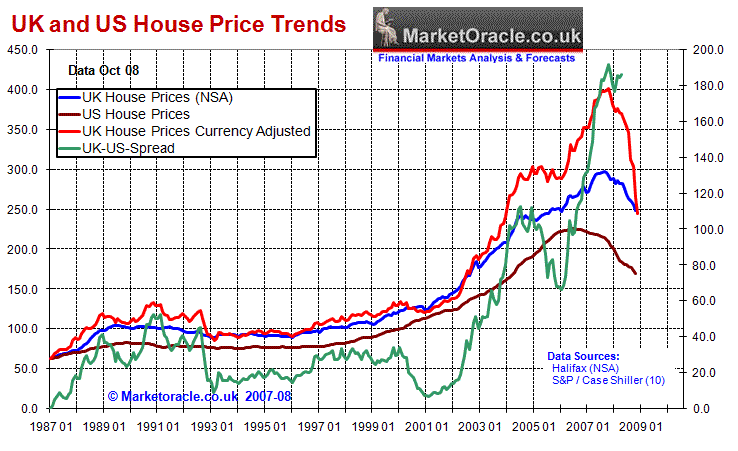
UK house prices had risen by 177% from January 1999, against US house prices that rose by 150% to their peak. However taking into account the currency trend, UK house prices rose by 238% with most of the gain occurring in the last 2 years of the bull market exaggerated by the U.S. Dollar Bear market. Whilst the rate of decline for both housing markets is similar allowing for the lag between each markets respective peak, what does stand out is the impact of sterling's crash over the past few months which has wiped out a further 30% of the value of UK house prices in terms of other major currencies including the U.S. Dollar and Euro, which therefore translates into a crash in UK house prices to date of 49%.
What this means is that the Labour government whether by design or circumstances is embarked on a programme of severe currency devaluation the effect of which is to inflate UK assets in nominal terms including the housing market. The immediate effect of the currency crash is to mask the crash in UK house prices from the public, however going forward this will result in much higher inflation and therefore a stagnating housing market for many years. Therefore the implications are for UK house prices to fall at a much lower rate than during the previous year.
Japan's House Price Depression
Many of the reasons put forward during the UK housing boom as to why house prices would not fall in the UK as elaborated earlier could equally apply to the Island of Japan. However, whilst we in the UK enjoyed a booming housing market the Japanese endured a severe bear market as the below graph illustrates.
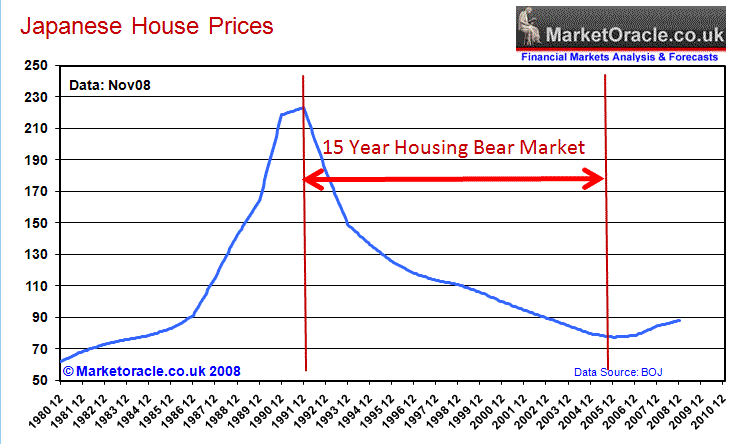
Japan's house prices peaked in 1991 and 18 years later still stand an average 60% below their peak. Whilst I am not saying that Britain's house prices could replicate Japans housing crisis some 18 years from now, however the Japanese experience does illustrate that house prices are NOT a one way bet, even on a long-term basis.
Credit Crisis Warning from Japan
The big warning from Japans credit crisis that resulted in what has come to be called the "lost decade" was that the bankrupt banks and corporations were NOT allowed to go bust, instead Japan cut and kept interest rates near 0% which ignited the overseas carry trade that fueled the asset price booms around the world as financial institutions borrowed at 1% from Japan and invested / loaned it out elsewhere, which was further magnified by the use of leverage. This coupled with America's own experience with ultra low interest rates of just 1% laid the ground for investor cash ever seeking riskier returns at increasingly leveraged levels that helped magnify U.S. subprime mortgage exposure by several orders of magnitude than the originating loan values.
Clearly the lessons from Japan have not been learned, instead of UK interest rates trending towards 3.5%, they are now at 2% and destined to hit 1% in January. This coupled with the money printing presses in full swing pumping out record amounts of debt is repeating the same mistakes as Japan, however with some major differences, both of which are negatives for the UK i.e. we do not have a trade surplus with the rest of the world, and nor are we sitting on foreign currency reserves north of $1 trillion. Therefore unlike Japan, economic deflation is likely to be followed by stagflation for the UK. It is far too early to say how high inflation will go as we have yet to feel the fill force of deflation. However this suggests that we won't experience prolonged asset price deflation Japanese style on nominal terms basis at least.
For more on the credit crisis see the Free Credit Crisis Survival toolkit.
UK Money Supply
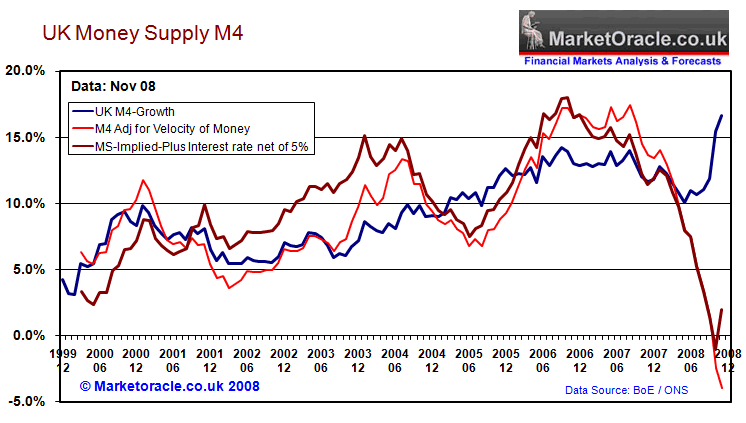
UK Money supply M4 (blue) has risen sharply from the 10% targeted low of mid 2008 to the current level of 16.6%, on face value this is highly inflationary and has been taken by many economists and market commentators to suggest much higher forward inflation. However the money supply adjusted for the velocity of money which takes into account the state of the economy as a consequence of the credit freeze tells a completely different story. The UK economy is now in extreme real monetary deflation of approaching -5%. The leading indicator of the implied money supply, is suggesting recent deep interest rate cuts of Novembers 1.5% and Decembers further 1% cut will lift future money supply growth out of extreme deflation, however it will still be far from supporting the levels north of 15% which accurately forecast forward inflation during 2008.
This therefore implies that that the whole of 2009 will be a deflationary period and thus supports a continued sharp downtrend in house prices on par with that of the last 12months at the rate of 16% per annum.
UK Inflation / Deflation
Recent analysis concluded that UK is heading for real deflation during 2009 as the below graph illustrates in that the RPI inflation measure is expected to go negative and spike lower around July 2009 as the RPI is sensitive to falling mortgage interest rates. The CPI will also continue to fall sharply into July 2009, which is targeting a rate of just below 1%. This therefore supports the view of a much weaker housing market during the first half of the year than the second half of 2009.
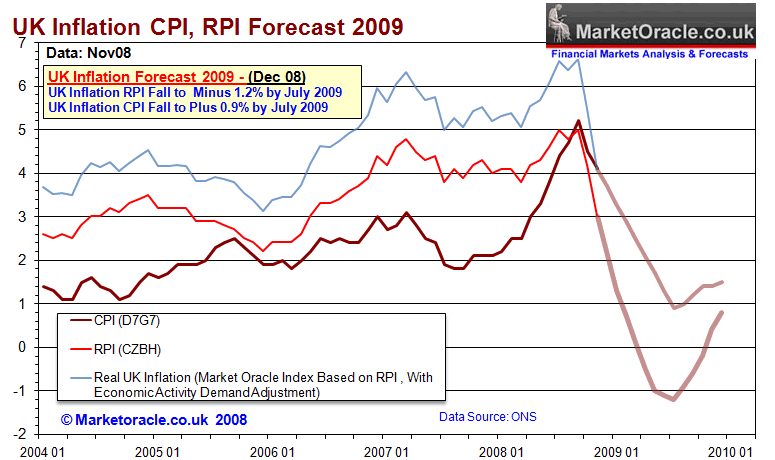
UK House Price Crash and Depression Forecast 2007 to 2012
In conclusion, the sum of the above analysis suggests that house prices having fallen by 19% are about half way to the lows, and therefore suggest that house prices will decline by 38% from the August 2007 peak. The housing market trend is clearly currently in the panic stage as we are witnessing near unprecedented house price falls at the rate of more than 16% per annum, far beyond that of the 1990's bear market. This rate of decline is not sustainable, and I am expecting this phase of the housing bear market to come to an end during the second half of 2009. However my expectation is that following the crash the market will enter a period of depression spanning several years after the market puts in a nominal price low and then embarks upon a weak up trend as the below graph illustrates.

Risks to the Forecast
The prime risk to the nominal house price forecast is the currency crash induced inflation, as earlier analysis suggested that house price falls can be brought to a halt by a significant currency devaluation, which has already taken place to the tune of 30%. This will mask the real terms house price falls that will make itself evident in the protracted housing market depression where house prices are not able to keep pace with inflation and therefore continue to erode in real-terms.
My next newsletter will aim to forecast the major trends for financial markets during 2009. To receive this on the date of publication subscribe to my always free newsletter.
By Nadeem Walayat
http://www.marketoracle.co.uk
Copyright © 2005-08 Marketoracle.co.uk (Market Oracle Ltd). All rights reserved.
Nadeem Walayat has over 20 years experience of trading derivatives, portfolio management and analysing the financial markets, including one of few who both anticipated and Beat the 1987 Crash. Nadeem's forward looking analysis specialises on the housing market and interest rates. Nadeem is the Editor of The Market Oracle, a FREE Daily Financial Markets Analysis & Forecasting online publication. We present in-depth analysis from over 150 experienced analysts on a range of views of the probable direction of the financial markets. Thus enabling our readers to arrive at an informed opinion on future market direction. http://www.marketoracle.co.uk
Disclaimer: The above is a matter of opinion provided for general information purposes only and is not intended as investment advice. Information and analysis above are derived from sources and utilising methods believed to be reliable, but we cannot accept responsibility for any trading losses you may incur as a result of this analysis. Individuals should consult with their personal financial advisors before engaging in any trading activities.
Nadeem Walayat Archive |
© 2005-2022 http://www.MarketOracle.co.uk - The Market Oracle is a FREE Daily Financial Markets Analysis & Forecasting online publication.
Comments
|
Frank
06 Jan 09, 14:43 |
Currency
Hi Given your comments on the pound against the USD and the posssibility to reach parity, I would be very interested in your forecast against the NZD. Cheers Frank |
|
07 Jan 09, 07:08 |
HPF
you are a wizard! |
|
Pez
14 Mar 09, 10:55 |
Pound vs Indian Rupee
We don't ever hear anything from you on the Indian economy. In particular I would be very interested to hear your thoughts on the Pound vs the Indian Rupee |
|
Nadeem_Walayat
24 Sep 09, 21:49 |
UK House Prices and Unemployment - Update Aug 09
This is the first in a series of analysis as part of an in depth up-date to the UK house price forecast of August 2007 that correctly called a peak in UK house prices and forecast a 2 year bear market that would see UK house prices fall by 15% to 25%. This analysis seeks to compare UK house prices against unemployment data. To ensure that you receive the full final analysis and conclusion / forecast for the UK housing market covering the trend for the next 2-3 years subscribe to my always free newsletter. UK Unemployment Data I have long questioned the accuracy and validity of the official unemployment data which over several decades and much manipulation by successive governments has been tweaked many hundreds of time to under report true unemployment for political purposes. Current official unemployment stands at 2.435 million for May data release against which the total are recorded as economically inactive of working age stands at 7.955 million which in my opinion is reflective of the true rate of unemployment as the below graphs illustrate.
Another poignant reminder of the lack of accuracy in the unemployment data is observed in the announcement today that now 1 in 6 house holds have no wage earner, i.e. all adults are unemployed in a total 3.3 million households, which clearly suggests a number of unemployed significantly above the 2.435 million official data of those unemployed. UK Unemployment Data Forecast The original forecast of October 2008 (July 08 data) as illustrated by the below graph, forecast UK unemployment to hit 2.6 million by April 2010. The actual data to date of 2.43 million to May 2009 clearly continues to suggest a much higher peak which remains on track to hit 3 million, as unemployment tends to lag economic recoveries by anywhere from between 6 to 12 months. UK House Prices Against Unemployment Trend Analysis
The above chart indicates that there does exist a strong relationship between house price trends and the unemployment benefit claimant count, more so than the unemployment data. The possible reason for this is that those made unemployed that do not claim benefits are not in as financially distressed state than those that have no choice but to claim benefits, therefore house prices can and have risen in the past whilst the official rate of unemployment rose, if at the same time the claimant count did not rise. The recent bounce in house prices is tracking quite closely with the stabilisation of the unemployment claimant count numbers, which therefore suggests that as long as those claiming unemployment benefits continues to stabilise at the current level of 1.6 million then the outlook remains positive for UK house prices to continue drifting higher, this is despite official unemployment data that looks set to continue to rise towards 3 million from 2.43 million. Existing UK House Prices Analysis and Forecast As mentioned earlier the original forecast of August 2007 concluded with a forecast drop in UK house prices of between 15% and 25% by August 2009, which has materialised. August 2007 Forecast Conclusion - The UK Housing market is expected to decline by at least 15% during the next 2 years. Despite the 2012 Olympics, London is expected to fall as much as 25%. UK Interest rates are either at or very near a peak, as there is an increasingly diminishing chance of a further rise in October 2007. After which UK interest rates should be cut as the UK housing market declines targeting a rate of 5% during the second half of 2008. The implications for this are that the UK economy is heading for sharply lower growth for 2008. This has been supported by over a hundred pieces of analysis on the UK housing market with several warnings not to pay any attention to the vested interest as they continued to remain in denial right upto the summer of 2008 with announcements such as that of a soft landing or that house prices would not fall, as Sept 07's article illustrated - UK Housing Market on Brink of Price Crash - Media Lessons from 1989! UK Housing Market 2008 Crash Trigger - Following the peak in UK house prices, the initial trend was inline with the original forecast, however it was recognised following Northern Rocks bust that the pace of deterioration of credit markets as well as the capital gains tax changes as implying that the UK housing market's rate of decent would start to accelerate from April 2008 and could be termed as a housing market crash - November 2007 - Crash in UK House Prices Forecast for April 2008 As Buy to Let Investors Sell. - The timing for the sharp drop is likely to coincide with Labour's change on capital gains tax which effectively cuts the tax payable on gains accumulated over the last few years to 18% from 40%. This tax change comes into force on 1st of April 2008 and thus the expectation is for an avalanche of selling amongst buy to let investors to lock in profits. This also means that the market will to some degree be artificially supported going into April 08, but still will not be enough to prevent a wider decline in UK house prices but rather could register a drop of as much as 5% in the quarter April 08 to June 08 , which would represent a crash in UK house prices. July 2008 - UK House Price Crash In Progress! - The summer months subsequently witnessed the crash in UK house prices come to pass as house prices look set to full fill the original forecast for a 15% fall well ahead of the original time line with the risks that despite soaring inflation data, the housing bear market threatened imminent deflation, which has now increasingly become the mainstream story which was originally highlighted in the analysis of March 2008. January 2009 - UK Housing Market Depression Forecast - In depth analysis of 4th January 2009, forecast a continuing crash that would morph into a prolonged depression for several years that despite containing bounces, that house prices were unlikely to see a final bottom until late 2011 / early 2012 as the below graph illustrates. March 2009 - House Price Bounce Warning Signs- The mainstream press as epitomised by the Telegraph ran with a ridiculous story that Uk house prices could fall by another 55%, which prompted analysis that concluded that the forecast for a possible another 55% fall in UK house prices EXTREMELY unlikely. If anything the extreme measures of zero interest rates and quantitative easing implied a far shallower trend that suggested a stagnating market rather than anything like another 55% drop.
Summer Bounce 2009 - The unfolding bounce or blip in UK house prices prices is inline with my May analysis that concluded that UK house prices will experience a bounce during the summer months from extremely oversold levels as a consequence of liquid buyers returning to the market and the debt fuelled economic recovery which 'should' be reflected in rising house prices during the summer months that is increasingly being taken by the mainstream press and vested interests to announce that the house prices have bottomed. My next analysis will compare UK house prices to the GDP growth rate. To ensure that you receive the full final analysis and conclusion / forecast for the UK housing market covering the trend for the next 2-3 years subscribe to my always free newsletter. By Nadeem Walayat http://www.marketoracle.co.ukCopyright © 2005-09 Marketoracle.co.uk (Market Oracle Ltd). All rights reserved. Nadeem Walayat has over 20 years experience of trading derivatives, portfolio management and analysing the financial markets, including one of few who both anticipated and Beat the 1987 Crash. Nadeem's forward looking analysis specialises on the housing market and interest rates. Nadeem is the Editor of The Market Oracle, a FREE Daily Financial Markets Analysis & Forecasting online publication. We present in-depth analysis from over 300 experienced analysts on a range of views of the probable direction of the financial markets. Thus enabling our readers to arrive at an informed opinion on future market direction. http://www.marketoracle.co.uk Disclaimer: The above is a matter of opinion provided for general information purposes only and is not intended as investment advice. Information and analysis above are derived from sources and utilising methods believed to be reliable, but we cannot accept responsibility for any trading losses you may incur as a result of this analysis. Individuals should consult with their personal financial advisors before engaging in any trading activities. |
|
You
18 Nov 09, 22:10 |
House Marketing
idk get it at all i need help on a description on how the current housing market has negetivly impacted the united states. |




